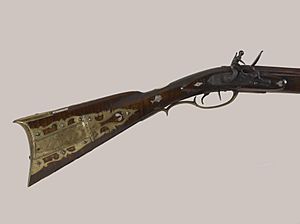Pennsylvania rifle facts for kids
The Pennsylvania rifle is a very special American gun. Around 1815, it became widely known as the Kentucky rifle. For many years in American history, it was the best gun for shooting long distances. German gun makers who moved to Pennsylvania in the early 1700s created this rifle. People living on the American frontier, like Daniel Boone in Kentucky, really liked it. This is why it got the name "Kentucky rifle."
Contents
History of the Kentucky Rifle
The Pennsylvania rifle came from an older, heavier gun called the Jaeger rifle. German gunsmiths brought Jaeger rifles to the American colonies. The Jaeger was a short, heavy rifle that fired a large bullet. It was used for hunting in Europe by wealthy people. However, both the Jaeger and the long, heavy smoothbore muskets of that time were not great for hunting in America.
Why Lancaster County Was Important
These gunsmiths mostly worked in Lancaster County, Pennsylvania. This area was a key trading spot. It was located between Philadelphia and the wild lands to the west. Lancaster County also had lots of iron ore for gun barrels and hardwood forests for gun stocks. The new rifle they developed could shoot much farther than older guns. The Pennsylvania rifle could hit targets accurately up to 300 yards (270 m). From about 1730 until the War of 1812, it was the top long-range rifle in America.
The Rifle in the American Revolution
During the American Revolutionary War, groups of Pennsylvania riflemen caused problems behind the British lines. They could shoot from far away, out of reach of the British Brown Bess musket. These militiamen and snipers could target individual soldiers and officers from a long distance. George Washington was very happy to have these skilled riflemen.
Most soldiers used muskets because they were faster to load in battle. But an American sharpshooter with a long rifle could pick off a British general. This could happen even if the general thought he was safe far from the fight. This skill helped change the outcome of several battles.
One story tells how a British general was angry that American frontiersmen were shooting his officers from far away. He ordered one of these marksmen and his gun to be captured. A raiding party brought back Corporal Walter Crouse with his long rifle. The British then made a mistake: they sent him to London. There, Crouse showed off his amazing gun. He hit targets daily at 200 yards. This was four times farther than the usual range of a musket! People stopped wanting to join the British army. So, King George III quickly hired German rifle companies to fight back with their own sharpshooters.
These sharpshooters are a big part of American history. They truly existed and played a major role in battles. Examples include the Battle of Saratoga in 1777 and the Battle of New Orleans in 1815.
Design of the Kentucky Rifle
This rifle had many names depending on where it was used. It was called the Kentucky rifle, Schimmel, southern poor boys, or Tennessee rifle. However, many were still made in Lancaster, Pennsylvania.
Rifle Features
A typical rifle of this design had a barrel between 42 inches (1,100 mm) and 46 inches (1,200 mm) long. It was usually .50 caliber (13 mm) and had a stock made of curly maple wood. The stock fully supported the barrel. Common features included a crescent-shaped buttplate, a patch box, and a cheekpiece. Early models used a flintlock firing mechanism. Later models used the percussion cap system. The barrels were rifled, meaning they had grooves inside to make the bullet spin and fly straight.
Daniel Boone's Rifle
Daniel Boone's rifle is a good example of a Pennsylvania rifle. It was 5 feet, 3 inches long (160 cm). It was .44 caliber and fired a ball that weighed about 130 grains (8.4 g). The gun itself weighed 11 pounds (5.0 kg). Using a bullet mold, Boone could make about 55 lead balls from one pound (0.45 kg) of lead. To fire a ball this size, he only needed a small amount of black powder.
Challenges in Battle
The Pennsylvania rifle was not good for hand-to-hand fighting. It was too delicate to use as a club. Hitting it against anything could break the stock. The long, thin wrought iron barrel was soft and could bend easily. Frontiersmen knew this and were careful not to damage their main hunting weapon.
In battle, it took twice as long to reload a Pennsylvania rifle as it did a Brown Bess musket. Also, because the barrel was so long, the shooter almost had to stand up to carefully measure the powder, load the ball and patch, and push it down with a ramrod. This is why Pennsylvania riflemen often hid behind trees to avoid enemy fire. The main weapon during the Revolutionary War for both sides was the musket. Fewer than 10% of American soldiers carried a long rifle.
See also
 In Spanish: Fusil largo para niños
In Spanish: Fusil largo para niños


